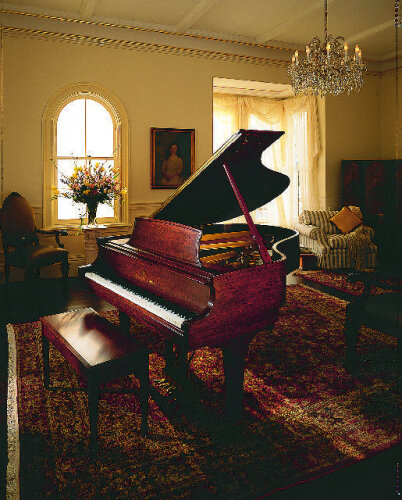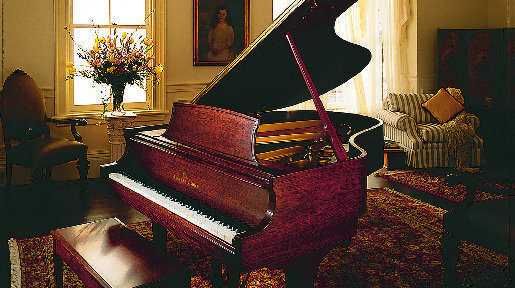A piano is not just a musical instrument but also a piece of furniture that becomes the focal point of the room.

A piano hits all the right notes in the homes of those who have musicality in mind. But, being a proficient piano player isn’t a prerequisite to having a music room, which can bring a note of sophistication to your house.
Not only can a piano be a key furnishing, it also becomes the focal point of the room in which it is placed, says Robert Berger, spokesman for Steinway & Sons in New York City.
“A piano blends artistry with craftsmanship and can be one of the most individual and significant pieces of furniture a person can buy,” Berger says. “Unlike other utilitarian pieces of furniture, a piano just naturally draws people to it, and can be handed down from generation to generation.”
The Steinway & Sons company has been handcrafting pianos since 1853 — a time when entertaining at home often centered around the piano. But even in today’s home, the piano has a timeless appeal and is still as grand in the 21st century, especially when families gather to celebrate, Berger says.
The beginning lesson toward creating a personal musical variation on a domesticated theme is to envision where a piano would be placed in a home.
“A piano is an instrument that is sensitive to the environment around it,” Berger says. “You do not want a piano to be placed in a basement or in a space where there are wide swings in temperature.”
Ideally, it is best to place a piano on an above-grade, inner wall of a home, away from heating and cooling vents or a fireplace. If a piano must be placed on an exterior wall of a home, keep it out from under windows or away from an exterior door.
Metal strings, felted pieces and wooden parts make a piano sensitive to swings in humidity levels and temperature. The materials that comprise a piano will swell and contract with these variations, which may affect the instrument’s “action” and tone when played.
Berger says a hygrometer — a device that measures the relative humidity in a room — is important to ensure conditions remain stable. Ideally, a home environment should have a relative humidity around 40 percent (or in the range of 30 to 50 percent, depending on the outside temperature), with an indoor temperature around 70 degrees.
After determining the perfect place for a piano in your home, prepare to spend time searching for the proper instrument that fits your performance preference, style aesthetic and budget. Most pianos are 5 feet wide, but vary in height and length.
In a grand piano, the soundboard and strings are positioned horizontally, and the length can range from nearly 5 feet to more than 9 feet long for a baby grand or concert grand, respectively.
In an upright piano, the soundboard and strings are placed in a vertical position, and take up less floor space than their grand counterparts. While most uprights are around 2 feet deep, the height varies — from about 36 to 50 inches tall — based on the piano type.
Reputable dealers often have a paper or cloth template to match the size of specific pianos, so a homeowner can visualize how the instrument will fit the space. Make sure to allow about 3 feet behind the piano for the bench placement and player.
Berger says it’s important to hire a reputable piano technician to ensure the instrument is sound, especially if you’re purchasing a used piano or inheriting a family heirloom. “People want the piano to look good in the room, but you also want it to sound as good as it looks,” he says. “A black, satin finish — or what we call ebony — is one of our most popular cases for Steinway pianos.”
A piano with a satin ebony finish complements different aesthetics — from modern to traditional — and adds to the home environment’s harmony. Try to keep the piano out of direct sunlight, because ultra-violet rays may cause color fading and age the finish prematurely. Instead, illuminate the instrument by placing a grand piano under a chandelier or by setting a specialty lamp on or near an upright.
Designing a music room must begin with the piano and start at floor level. Acoustically, a piano will sound louder in a room with hardwood or tiled flooring. Conversely, the sound will be more subdued if a piano is placed on an area rug, surrounded by draperies, with a lowered lid on the grand piano. The placement of chairs and sofas is music to the ear when the seating arrangement works around the placement of the piano.
The cost of a piano — whether you’re buying a used one for thousands, or a new one for tens of thousands of dollars — is an investment that requires regular maintenance. Have a piano tuned at least twice a year — in the winter and summer — after turning on the heating and air conditioning.
When not in use, keep a piano’s lids and covers closed to minimize dust on working parts, which include the strings and keys. A piano’s case can be dusted with a lightly dampened cloth — using water, not furniture polish — and wiped dry.
If maintained properly, a piano can be enjoyed for generations to come. “A piano in the home can evoke an emotional response, much like a beautiful painting,” Berger says. “But, unlike a painting, a piano is a piece of living art, that — once it is played — can bring life to a home.”
Resources that are music to the ear:
- Piano Technicians Guild, www.ptg.org
- Steinway & Sons, www.steinway.com
